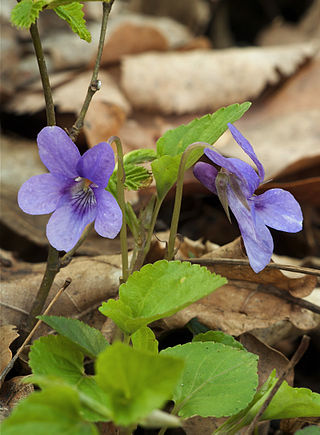
Viola is a genus of flowering plants in the violet family Violaceae. It is the largest genus in the family, containing over 680 species. Most species are found in the temperate Northern Hemisphere; however, some are also found in widely divergent areas such as Hawaii, Australasia, and the Andes.

Violaceae is a family of flowering plants established in 1802, consisting of about 1000 species in about 25 genera. It takes its name from the genus Viola, the violets and pansies.
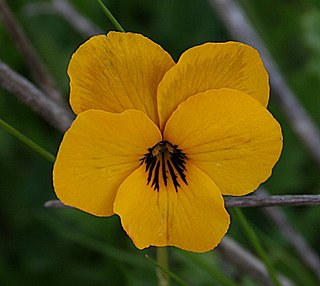
Viola pedunculata, the California golden violet, Johnny jump up, or yellow pansy, is a perennial yellow wildflower of the coast and coastal ranges in California and northwestern Baja California. The common name "Johnny jump up" is usually associated with Viola tricolor however, the introduced garden annual.

Viola elatior, the fen violet, is a species of violet native to central and northern Europe and northern Asia. In the British Isles it is very rare, occurring in a few fens in England and near the western coast of Ireland.

The grove snail, brown-lipped snail or lemon snail is a species of air-breathing land snail, a terrestrial pulmonate gastropod mollusc.
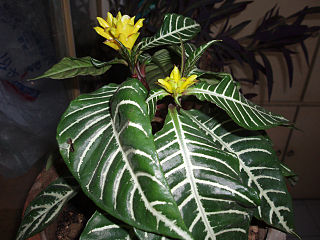
Aphelandra is a genus of over 200 species of flowering plants in the family Acanthaceae, native to tropical regions of the Americas.

Viola canadensis is a flowering plant in the Violaceae family. It is commonly known as Canadian white violet, Canada violet, tall white violet, or white violet. It is widespread across much of Canada and the United States, from Alaska to Newfoundland, south as far as Georgia and Arizona. It is a perennial herb and the Latin-specific epithet canadensis means of Canada.

Viola sororia, known commonly as the common blue violet, is a short-stemmed herbaceous perennial plant native to eastern North America. It is known by a number of common names, including common meadow violet, purple violet, woolly blue violet, hooded violet, and wood violet.
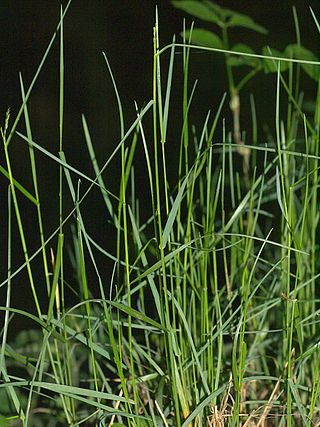
Poa nemoralis, the wood bluegrass, is a perennial plant in the family Poaceae. The late-growing grass is fairly nutritious for livestock, which feed on it in the autumn, and it is used as a lawn grass for shady situations.
The elm cultivar Ulmus 'Nemoralis' was listed by Schelle in Beissner et al. (1903), as U. campestris f. nemoralisHort. Considered "possibly U. carpinifolia " by Green.

Brachystephanus is a genus of flowering plants in the family Acanthaceae. It includes 21 species native to tropical Africa and Madagascar.
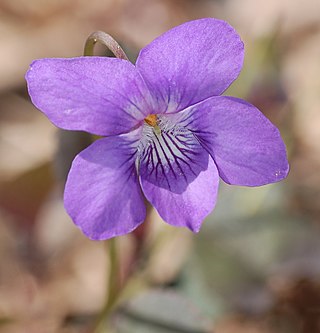
Viola labradorica, commonly known as alpine violet, American dog violet, dog violet or Labrador violet, is a perennial herbaceous flowering plant. It is native to Greenland, eastern Canada, and the eastern United States. The plant sold as Viola labradorica by nurseries is Viola riviniana.

Kyllinga is genus of flowering plants in the sedge family known commonly as spikesedges. They are native to tropical and warm temperate areas of the world, especially tropical Africa. These sedges vary in morphology, growing to heights from 2.5 centimeters to a meter and sometimes lacking rhizomes. They are closely related to Cyperus species and sometimes treated as part of a more broadly circumscribed Cyperus.

Solidago nemoralis is a species of flowering plant in the family Asteraceae. It is native to North America, where it is widely found in Canada and the United States. Its common names include gray goldenrod, gray-stem goldenrod, old-field goldenrod, field goldenrod, prairie goldenrod, dwarf goldenrod, and dyersweed goldenrod.

Phacelia nemoralis is a species of flowering plant in the borage family known by the common name shade phacelia. It is native to the west coast of the United States from Washington to central California, where it grows in moist, usually forested areas along the coastline and in the coastal mountain ranges.

Anthocoris nemoralis is a true bug in the family Anthocoridae. The species is native to Europe and is introduced in North America. It is a predator of aphids, spider mites and jumping plant lice, and is therefore used as a biological pest control agent.
Yevgenia Georgievna Pobedimova (1898-1973) was a Russian-Soviet botanist and plant collector noted for describing over 270 species in Russia, Ukraine and North Asia.

Glyceria nemoralis is a species of grass in the family Poaceae.
Morsacanthus is a monotypic genus of flowering plants belonging to the family Acanthaceae. The only species is Morsacanthus nemoralisRizzini.
Cyperus nemoralis is a species of sedge that is endemic to central Madagascar.
















